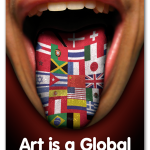Pictures: Conveying Meaning Through it Parts
The three photos I decided to use all depict a woman. This woman is the root of all the images, for she is the main focal point of the pieces. It is her that is the source of the image in which the viewer emotional connects to the piece.
In the first image, the woman cries as she thinks about a man. At this moment, it is unclear whether they are romantically involved, until you view the other two images. Once viewing the other two pictures, it becomes apparent that the man is her significant other. But the third image creates further confusion, for the woman may no longer love her partner.
In the first image, the thought of the man is an unbound affix. Although he is unbound, he is derivational. This is because, the thought of the man gives significant insight to the emotion the woman is feeling. She is either saddened over him or misses him. The emotion of sadness is conveyed through the way her mouth forms a frown, while in the second image it appears to be a smile conveying a sense of pleasure.
In the second image, the man is an unbound derivational affix as well. This is because, without the man, the viewer would not be able to understand why the woman is crying and an incorrect assumption would most likely be drawn. For the woman is crying due to overwhelming joy, but if the man wasn’t there holding her, she would merely appear sad.
The tears the woman is shedding may be considered an allomorph but I would argue against it, for in the first image they appear to be tears of sorrow. But in the second image I believe the tears are tears of joy. This is because she is reunited with her lover and she is crying because she is so happy that they are together. In either case, the tears are bound affixes for on their own they wouldn’t convey significant meaning, but attached to the woman, the viewer is able to sympathize and understand how the woman feels.
In the last image though, the woman maintains a blank composure. She has a slightly empathetic look on her face, but I feel that is because she is about to break it off with her boyfriend. She says, “I love you, too… But…” This creates a very ominous feeling in the viewer; as if the woman is about to say something she doesn’t want to say but has too. The speech bubble in the third image is an unbound derivational affix, for without it, the piece’s meaning would be unclear to the viewer.
#roylichtenstein #popart #comicart #morphology #visualdissection







 D5 Creation
D5 Creation
Excellent analysis. I agree with you about the tears– these are more likely homomorphs morphemes that look the same but mean different things, like the -er in “faster” and the -er in “runner”) than allomorphs. And I absolutely like how you decided that the man was a derivational rather than inflectional morpheme. But I think the thought-of-the-man might be bound, no? Could the thought of the man exist without the root image of the woman?
-dsb